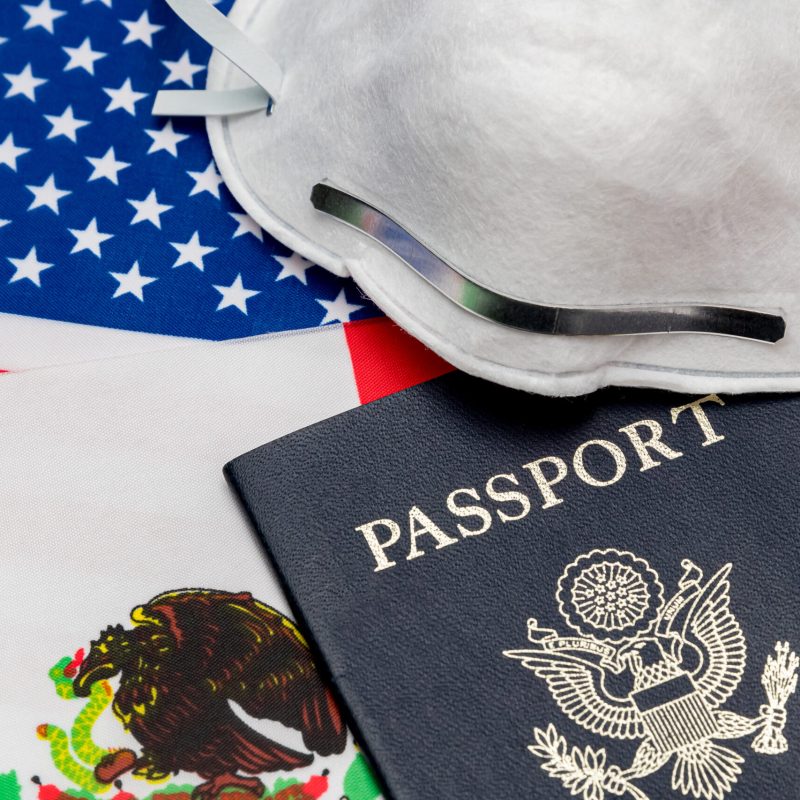
N95, KN95, and KF94 masks have become familiar household terms since the COVID-19 pandemic. Generally, people know that N95 respirators are considered to be the most protective face coverings, while KN95 and KF94 masks are a slight step below. However, many are not familiar with how these popular types of face coverings are differentiated. The N95 respirators, KN95 masks, and KF94 masks have different minimum certification requirements, provide slightly varied levels of self-protection correlated to this, and are worn differently. Read on to find out the differences between these surgical masks and which should be chosen for flying and other travel activities.
Videos by TravelAwaits

N95 Respirator Masks
N95 respirator masks are National Institute for Occupational Safety and Health- (NIOSH) approved facepiece designed for air filtration around the mouth and nose. These face coverings received their (now) household name, “N95,” from their NIOSH N95 air filtration classification, meaning these masks effectively filter at least 95% of airborne particles. All authentic N95 respirators are marked with the NIOSH stamp, the filter class (N95), a 7-digit approval number that corresponds to the NIOSH Certified Equipment List, and are outfitted with headbands instead of ear loops. It is important to note that other countries have different minimum standards, so these standards only apply to NIOSH-tested respirators.
The correct identifier of N95 face coverings is the term “respirator,” not “mask.” “Respirator” is an exclusive term given only to those face coverings that protect the wearer from airborne particles and are designed to seal as tightly as possible to the face. Masks, on the other hand, are traditionally designed more as a barrier to droplets and spit. N95 respirators also need to be cleaned meticulously and are constructed for very few reuses in order to keep the secure fit intact.
Each N95 respirator requires a very specific design, consisting of fine mesh synthetic polymer fibers. Each is then created by melt blowing, which involves combining a polymer melt with high-speed blowing gas to form the nonwoven sheet on the inner filtration layer that filters out hazardous particles. This secure design has made the N95 respirators a necessary piece of personal protective equipment for medical professionals and those in industrial work, especially painters, miners, and construction workers.
N95 Surgical Respirators
N95 respirators cleared for medical use are labeled “Surgical N95” on each mask and are to be used in medical settings only. However, exceptions have been made during crises and shortages, including the COVID-19 pandemic, to allow medical professionals to use industrial-grade N95 respirators when their surgical stash is depleted. In addition to the air filtration specifications, surgical N95 respirators also require meeting a minimum fluid-resistant certification, measured by testing the mask’s resistance to a stream of artificial blood.

KN95 Masks
Remember when we mentioned that other countries have different standards for certifying respirators? Well, KN95 respirators are the face coverings that meet China’s minimum level of air filtration control but are not regulated by NIOSH standards in the United States. In a recent study, the nonprofit group ECRI, or the Emergency Care Research Institute, tested approximately 200 randomly selected masks across multiple brands and determined that 60-70% of them did not meet the 95% airborne particle filtration minimum required by NIOSH for N95 respirators.
However, considering N95 is the highest standard when it comes to airborne filtration, do not dismiss the protective qualities of KN95 masks! While the KN95s are not NIOSH-approved, they are CDC and FDA-approved. The correct term for KN95 face coverings is also “respirator,” as they still offer an effective face filtration system. In a recent test conducted by 3M, it was determined that KN95 respirators have a total inward leakage, or TIL, of less than or equal to 8% compared to 0% from the tested N95 respirators. The TIL percentage is determined by the amount of a specific aerosol that enters the tested respirator facepiece via both filter penetration and face seal leakage.
Similar to the N95, KN95 respirators are designed with a 3-layer filtration system and a tight-fit adjustable noseband. As previously mentioned, they are not NIOSH- nor Nelson Lab-approved, and they are outfitted with more flexible ear loops versus the headbands required on N95s. The CDC understands the different standards are easily confused by the general public, so they conducted independent tests on multiple KN95 brands to determine efficacy and published easy-to-follow results by brand here.

KF94 Masks
KF stands for “Korean filter” and this mask is the South Korean equivalent to the U.S.’s N95 mask. As the name also implies, KF94 masks provide >94% filtration efficacy, just a slight step below KN95. Like KN95’s, these masks are not regulated by NIOSH standards in the United States. However, the U.S. has conducted multiple studies on the KF94 masks and concluded they are indeed more effective in blocking COVID-19 particles than basic 3-ply surgical and cloth masks.
Aside from the regulation requirements, the main difference between KF94 masks from N95 and KN95 masks is that these masks are made of non-woven fabric. The masks provide protection via their four-layered design and secured behind the ears with adjustable straps, like the KN95. KF94s basically combine the protective and filtration layers of the N95 and KN95s into a cloth version, which many people (and children) may find more comfortable. Another bonus of the KF94s is that they typically cost less and are more readily available than the other two.

N95 Vs. KN95 Vs. KF94: Comparison By The Numbers
One of the best mask type explanation graphs comparing N95 masks and KN95 masks we’ve found is the Protectly graph, which details filter performance, flow rate, total inhalation leakage, and other specifics the masks are tested on. While the N95 performed the best across all 11 metrics, the KN95 was only a slight step below on a few like leakage rate and inhalation resistance. The KF94 has not been FDA-registered, but it is KFDA-approved, the Korean equivalent to the United States FDA.
Which Mask Is Best For Traveling?
So, what mask, or respirator, should be chosen for travel? Traditionally, N95 respirators are the safest option for flying on airplanes since it’s imperative to have the highest level of air filtration and protection while sharing recycled air with strangers for hours. Plus, no matter where you reside, face coverings are currently required in all airports and airplanes. The Protectly RespoKare N95 has 4-layer protection, above and beyond the NIOSH required 3-layers, capable of securing and blocking 95% of particles as small as 0.3 microns. The RespoKare is the first and only FDA-approved anti-viral mask. It inactivates up to 99.9% of particles within minutes to further decrease human-to-human airborne transmission of 18 common seasonal and pandemic viruses, as well as an extended range of other bacteria, fungi, and pathogens. As required by all certified N95s, these masks are designed to stay securely fashioned to the wearer’s face to avoid unintentional slipping while maneuvering throughout and hours spent on the plane.
However, for regular activities once arrived at the chosen destination, the KN95 mask and KF94 masks are both excellent options. When navigating outdoors and easily social-distanced areas, these masks are sufficient protection and suitable as equivalent options according to both 3M and the CDC. Protectly’s KN95 masks have been tested and FDA-registered to filter at least 95% of non-oil airborne particles. The 5-layer masks with adjustable ear straps are more comfortable for long-term wear. Protectly offers both USA-made and China-made options. Protectly’s KF94 masks have been tested and KFDA-approved to filter up to at least 94% of harmful particles. The 4-layer masks are easier to breathe out of and also comfortable to wear for long periods of time. Another strong positive for the KF95 masks are the different size options and adjustability, which make them safe and form-fitting options for children.
Although traveling and flying may be rocky waters to navigate at the moment, be prepared when you do. The Protectly authentic and certified collection, ranging from the highest-rated N95 respirators to surgical triple-layer masks, will supply everything needed for a comfortable and, most importantly, safe and healthy, travel experience.
Related Content
- TSA Extends Mask Requirement For Airline Passengers
- Several Airlines Now Banning Cloth Face Coverings During Flights
- 21 Expert Tips For Traveling Internationally Right Now
The information found on TravelAwaits is intended for informational and educational purposes only and not for the purpose of rendering medical advice. Always seek the advice of a physician or other qualified healthcare provider with any questions regarding a medical condition.

